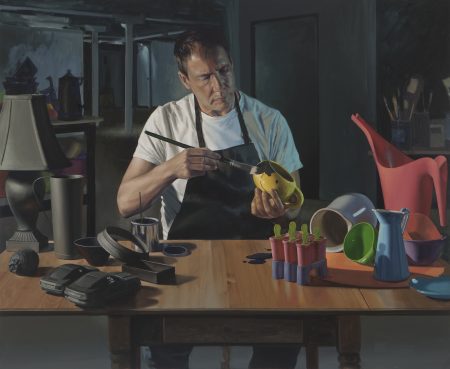A contemporary analysis of social stress is the subject of investigation of Perin Mahler’s colorful, large scale narrative figure paintings at the Manifest Gallery in Walnut Hills. On viewing this work serially, one cannot avoid becoming cognizant of the artist’s social perceptions as well as his personal introspections which inspire the narrative scenarios of these works.
Mahler states: “I am inspired by crisis, … the paintings in this exhibit address the emotional impact that difficult events or personal interactions have had on me.”
“Factions”: A multi person public confrontation between reddish collar-shirted people on the left and a variety of blue tee’d participants on the right is depicted in a frieze format. Set in an urban public space, the figures exhibit various stages of protest, rage and violence as angry verbal expressions fly and sticks are held high precipitating the act of assault. As their movements surge in the center of the painting, the colors of their shirts intensify to higher chromatic versions. Multiple hands tighten and clench as the compacted male and female figures converge to the center of the work. Here the inflamed faces are only inches apart. Their painted bodies and gestures disintegrate, shredding and fragmenting on impact. The intensified colors blend into a fractured half figure of unique deep purple, a chromatic crisis symbolizing social ground zero.
Another emotionally raw work is the painting entitled “Factions 2”. Formatted as a vertical, this painting explores this dynamic point of social conflict. The closeness of the figures bring the viewer immediately into the fray. Angry faces and flailing fists are painted as if moving through each other, fracturing on physical impact but without philosophical dissuasion. Mahler employs a claustrophobic dynamic creating a visual impact that is jarring and intense.
Mahler shows two single figure paintings which convey his assessment of his personal domain and domestic stress. The doctrine of Nihilism, professed by an extreme Russian revolutionary party c. 1900, is defined as “finding nothing to approve of in the established social order”. In the self-portrait “Paint it Black”, Mahler portrays himself calmly seated at a veneered drop-leaf table, painting a bright yellow happy face coffee mug black. Plastic freezer pops to oil change funnels, pitchers and watering cans, are among the multiple items of domestic tranquility signaling both gaiety and utility. These reflect colorfully in the veneer as they stand ready to be transformed. Several items standing on the other side of the table, have already been painted black, a lamp with shade, a piggy bank, two toy cars, among others. These have no reflection on the table top but cast only shadows. Mahler’s stoic concentration in this act of painting contrasts in my mind with the driving percussive force and agitated vocals of “Paint It Black”, the Rolling Stones anthem which became a mantra of the Vietnam era protests. The lyrics used the absence of color as the whole world was painted black to delineate the profound disillusionment with establishment military and domestic policies of the era.
In “Atlas”, Mahler portrays himself in the classic pose of the Greek Titan, barefoot on bended knee as the weight of an impossible construct forces him to the earth. Supporting the tremendous clutter of family and professional life, studio lamps, laundry baskets, and neglected hobbies, Mahler’s figure is crushed into the lower third of the painting. Items begin to fall as his balancing efforts fail.
Another work with hint of dark humor portrays the efforts of loving parents to celebrate their child’s birthday with a party. The central figure is Dad, astride a unicycle with Vaudevillian flair, his classic panama hat is replaced with a birthday cake complete with lit candles. Symbolic of his professional responsibilities, he balances multiple books on a paint brush as he leans in to present the birthday girl with her piece of cake. Mom attempts to influence the situation but the child’s hands remain at her side. Her disgusted facial expression and spread leg stance indicates that she is not impressed with the orchestrated parental efforts and neither are the juvenile party participants. The father figure in bright orange shirt and khaki pants, dominates the composition like a giant ‘Y’, perhaps intentionally questioning the endeavor. Children in screaming disarray are cavorting mischievously about. The young man in the foreground however is maliciously taking aim at the main character’s midriff with a slingshot, precipitating a looming disaster.
Mahler imbues his multi-layered narrative paintings with commentary, introspection and wit through his use of allegory and symbolism. His compositional devices, exceptional figure painting and adroitly employed color palette contribute to the unfolding narrative of each work.
This exhibition is on view through April 3, 2020.
Marlene Steele paints and teaches in Cincinnati Ohio






